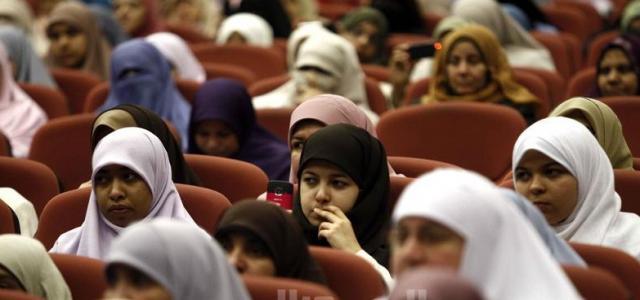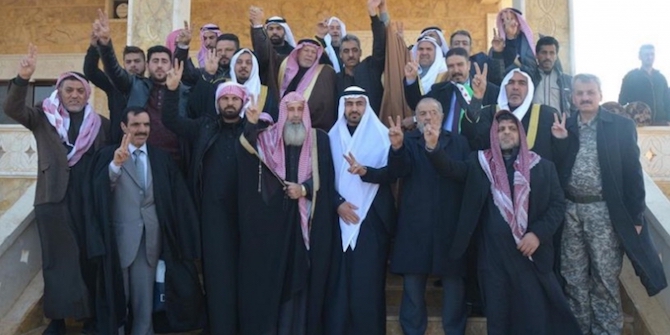by Courtney Freer

The Muslim Brotherhood’s Views on Women
The Muslim Brotherhood, founded in 1928 by Hasan al-Banna, was initially conceived of as a social movement seeking to re-Islamise Egypt. Its first bylaws even explicitly listed the goal ‘to raise a generation of Muslims who would understand Islam correctly and act according to its teachings.’ As a result, the group, and its founder, had definite views on the place of women in a proper Muslim society, largely informed by events of the time. The Society, at its start, differed from other Islamic reform movements in its focus on improving socioeconomic conditions and promoting social justice. Still, the Brotherhood’s bylaws prohibited direct political action until 1934, and it was not until its sixth conference, in 1941, that the Society chose to participate in parliamentary elections.
The Muslim Brotherhood’s first activities focused on tarbīa (usually used in reference to educating or raising children in accordance with Islam) as a means of re-Islamising society from the grassroots, since the road to an Islamic society necessarily involved the conversion of individuals. Al-Banna’s ultimate goal was to create an Islamic society without political parties or socioeconomic classes (see page 146 in Brown’s Religion and State). The state, in al-Banna’s conception, was instrumental to the re-Islamisation of society.
Women also played an important part in al-Banna’s rebuilding of proper Muslim society. He listed the following as major goals of social reform pertaining specifically to woman:
a campaign against ostentation in dress and loose behavior; the instruction of women in what is proper, with particular strictness as regards female instructors, pupils, physicians, and students, and all those in similar categories [….] a review of the curricula offered to girls and the necessity of making them distinct from the boys’ curricula in many stages of education [….] segregation of male and female students; private meetings between men and women, unless within the permitted degrees of relationship, to be counted as a crime for which both will be censured…the encouragement of marriage and procreation, by all possible means; promulgation of legislation to protect and give moral support to the family, and to solve the problems of marriage…the closure of morally undesirable ballrooms and dance-halls, and the prohibition of dancing and other such pastimes
The primary issues for al-Banna, then, appeared to be the behaviour of women in public, their education, and the prevention of gender mixing, which he considered inappropriate. Unsurprisingly, al-Banna envisioned a separate women’s division as an outlet for female involvement, and the Muslim Sisters Group was established in 1932, comprising primarily relatives of Brothers. The group was limited solely to women yet remained under the authority of the Brotherhood’s Supreme Guide; a female deputy communicated directly with him, yet Shaykh Mahmoud al-Gohary was appointed to supervise the women’s group and report about its activities to al-Banna. In the words of al-Gohary, ‘these were two different entities altogether, and they never congregated.’ Indeed, al-Banna said that ‘the Sisters should contribute as much as their conditions allow them to the Brotherhood’s “reform program,”’ and they were primarily focused on social services and charity activities, rather than the political agenda. Looking at present-day rhetoric from Muslim Brotherhood movements throughout the Middle East, it becomes clear the extent to which this discourse has not been updated, in keeping with the expansive economic, political, and social changes that have taken place since al-Banna’s lifetime.
The Influence of Islamist Rhetoric on Women’s Rights
Even today, for a movement with ambitious political aims, it is striking how much time the Muslim Brotherhood spends in discussing the so-called ‘woman problem.’ Because Islamists hope to change society as a whole, largely through the imposition legislation on social issues, the role of women is referenced in much of their literature. Certainly, as Lisa Blaydes points out, ‘Islamist political activity also focuses on issues related to public morality where women are a frequent target of social control.’ Further, the honour of men is very much linked to the activity of women to whom they are related, making issues of female reputation central. In addition, because of their role in educating the next generation, women are also critical to the perpetuation of existing patriarchal structures.
Another reason for the Brotherhood’s focus on women is their role as symbols in the group’s attempts to supplant what is perceived to be Western cultural hegemony with Islamic culture. Lisa Taraki argues that ‘feminism was equated with cultural imperialism,’ and thus Islamism became part of the resistance against the West. Leila Ahmed goes further, claiming ‘Islamist discourse on women as a discourse of resistance.’ Indeed, because women’s dress and behaviour could be seen most clearly ‘as proof of the moral bankruptcy of the West and the superiority of Muslims,’ it became central to the Brotherhood’s cause. As a whole, then, Islamists hoped to supplant Western influence by pushing their own alternative of reconstructing Islamic culture opposed to aspects of westernisation and even of Arab traditions.
Taraki goes on to explain that Islamists have become even more preoccupied with women and their behaviour due to changing gender relations as economic changes have forced more and more women to join the workforce, making the debate about how they behave in public of immediate and practical relevance in a way that it was not at the time of the Brotherhood’s establishment. Only when lower middle and middle class women were forced to work were they truly in public and thus in contact with men. Not only does an increasing number of women in the workforce require Islamist comment, so too does increased female education levels.
Despite the seeming centrality of women’s issues, and particularly their morality, to the Islamist cause, most Islamist groups do not discuss women’s issues with much specificity or elasticity. In fact, ‘Islamists have interacted with women in a limited way to the extent that people think that Islam means nothing to women but the hijab, staying at home, and fighting taburruj [display of beauty] and immorality.’ Nonetheless, some of the most pressing issues facing Islamists today concern women, specifically their participation in public space, their appearance and conduct, and how they relate to and interact with men. As women become more educated and are more likely to work in the public sphere alongside men, issues of gender mixing and relations have become more pressing.
Female Participation and Islamists
One inconsistency between Islamist views towards women, particularly their role in the public sphere, is the involvement of women in Islamist political parties – which may be considered a sign of female political empowerment. One famous example is the Kuwaiti Brotherhood’s resistance to women gaining the right to vote and the subsequent importance of women in their electoral success. The Egyptian Brotherhood, as noted by Sherifa Zuhur, has divided gender issues into those that are negotiable and non-negotiable: while there is limited flexibility with regard to education and family planning, theory remains unchanged.
Indeed, in most Brotherhood groups, women’s activities are restricted to specific female sections, as seen in the mother Egyptian group. Within these sectors, women ‘are expected to run welfare programs and charitable societies attached to the movement and recruit other female members and disseminate knowledge about Islam by reaching out to other women.’ In this way, Brotherhood women can come to dominate countrywide women’s groups, benefitting from their organisation. Nonetheless, Islamist women tend to be involved publicly primarily through charity and da’wa, rather than as parliamentary candidates.
Still, women have become increasingly important in other sectors, particularly through student union elections where the Brotherhood traditionally does well. Since women form the majority of students in most countries of the Middle East, their support is critical to winning student union support; the same can be said for certain professional associations as well. Their sustained electoral backing may increasingly require that certain policies be undertaken or greater visibility for specific women or policies.
Islamists and the International Women’s Movement
Following the ratification of the Convention on the Elimination of all Forms of Discrimination Against Women (CEDAW) in Jordan (it has been ratified by all Middle Eastern and North African countries except Iran, Somalia, South Sudan, and Sudan), complaints arose from Islamists. Ibtesam Alatiyat and Hassan Barari outline three main areas of contention between Islamists and the international women’s movement: support for CEDAW, laws relating to the status of women and men (especially personal status law and honour killings), and the use of quotas to promote female political representation.
On the topic of CEDAW, Jordanian Islamists used the slogan ‘liberating with Islam and not from Islam’ to fight ratification, contending that absolute equality harms the complementary relationship between men and women. ‘Another Islamist criticism of CEDAW targets its lack of reference to and recognition of religion. Even worse, “the Convention looks at religion as a cultural barrier that hinders women’s progress.”’
Issues of personal status and honour killings often reflect understandings of traditional or tribal culture, rather than strictly Islamist ideology or even Islamic law. Still, Islamists, many of whom share a tribal background recognise that honour killings are tribal, rather than Islamic, acts. While they are not willing to criticise the practice outright, for fear of losing electoral support, many ‘question the motives behind the campaign to eliminate the law that will impede the practice.’
Interestingly, Islamist support for democracy, which has become increasingly incorporated into local Brotherhood agendas, has not led them to adopt a stance in favour of absolute equality of men and women. While education for women is often stressed, females rarely have leading public roles in Islamist politics, suggesting that their role, though important, is considered fundamentally (and necessarily) different from that of men.
In this series:
- Introduction by Courtney Freer
- A Survey of Knowledge of and Attitudes toward Article 153 among Kuwaiti Citizens by Justin Gengler
- Is Female Suffrage in the Gulf important? by Hatoon Al-Fassi
- Saudi Women: Navigating War and Market by Madawi Al-Rasheed
- Disciplinary Violence in Kuwait by Alanoud Alsharekh
- Gender equality in Iraq and Iraqi Kurdistan by Zeynep Kaya
- Sexual Violence against Women during Displacement by Zeina Awad
- Women’s Access to Justice for Gender-Based Violence in Universal and Regional Human Rights Law by Lisa Gormley
- Assessing the Role of Security Forces on Women in Conflict Zones: Perspectives from International Law by Antonia Mulvey






